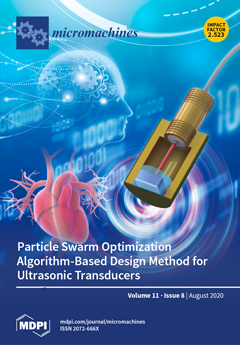In this paper, we report a novel microfluidic method to conduct a
Caenorhabditis elegans electrotaxis movement assay and neuronal imaging on up to 16 worms in parallel.
C. elegans is a model organism for neurodegenerative disease and movement disorders such as Parkinson’s disease
[...] Read more.
In this paper, we report a novel microfluidic method to conduct a
Caenorhabditis elegans electrotaxis movement assay and neuronal imaging on up to 16 worms in parallel.
C. elegans is a model organism for neurodegenerative disease and movement disorders such as Parkinson’s disease (PD), and for screening chemicals that alleviate protein aggregation, neuronal death, and movement impairment in PD. Electrotaxis of
C. elegans in microfluidic channels has led to the development of neurobehavioral screening platforms, but enhancing the throughput of the electrotactic behavioral assay has remained a challenge. Our device consisted of a hierarchy of tree-like channels for worm loading into 16 parallel electrotaxis screening channels with equivalent electric fields. Tapered channels at the ends of electrotaxis channels were used for worm immobilization and fluorescent imaging of neurons. Parallel electrotaxis of worms was first validated against established single-worm electrotaxis phenotypes. Then, mutant screening was demonstrated using the NL5901 strain, carrying human
-synuclein in the muscle cells, by showing the associated electrotaxis defects in the average speed, body bend frequency (BBF), and electrotaxis time index (ETI). Moreover, chemical screening of a PD worm model was shown by exposing the BZ555 strain, expressing green fluorescence protein (GFP) in the dopaminergic neurons (DNs), to 6-hydroxydopamine neurotoxin. The neurotoxin-treated worms exhibited a reduction in electrotaxis swimming speed, BBF, ETI, and DNs fluorescence intensity. We envision our technique to be used widely in
C. elegans-based movement disorder assays to accelerate behavioral and cellular phenotypic investigations.
Full article






